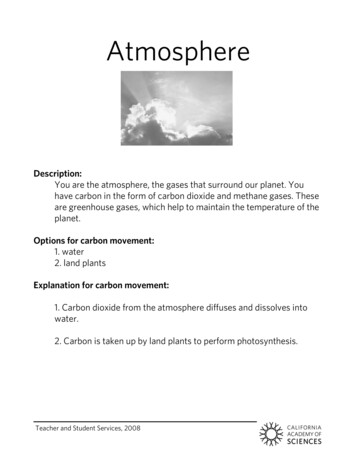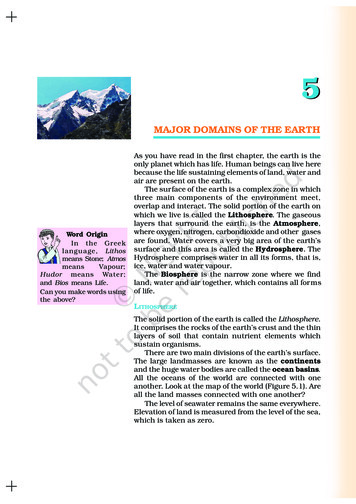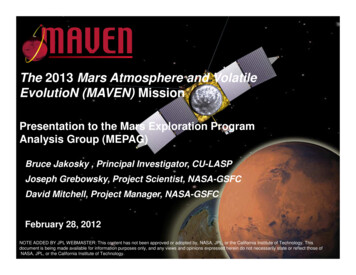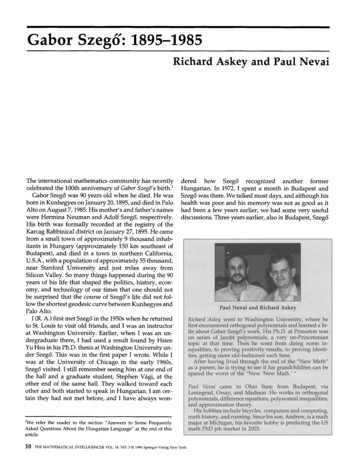
Transcription
AtmosphereDescription:You are the atmosphere, the gases that surround our planet. Youhave carbon in the form of carbon dioxide and methane gases. Theseare greenhouse gases, which help to maintain the temperature of theplanet.Options for carbon movement:1. water2. land plantsExplanation for carbon movement:1. Carbon dioxide from the atmosphere diffuses and dissolves intowater.2. Carbon is taken up by land plants to perform photosynthesis.Teacher and Student Services, 2008
WaterDescription:You are the water on our planet. Carbon dioxide gas dissolves inwater and allows aquatic plants to perform photosynthesis. Carbon inwater also helps certain aquatic animals make their skeletons andshells.Options for carbon movement:1. aquatic plants2. aquatic animals3. atmosphereExplanation for carbon movement:1. Aquatic plants use carbon dioxide from the water to performphotosynthesis.2. Some marine organisms take carbon from the water to buildtheir skeletons and shells.3. Carbon dioxide can diffuse from the water back into theatmosphere.Teacher and Student Services, 2008
Aquatic PlantsDescription:You are aquatic plants. You get carbon dioxide from the wateraround you to perform photosynthesis.Options for carbon movement:1. water2. sediments and rocks3. aquatic animalsExplanation for carbon movement:1. Cellular respiration and decomposition put carbon back into thewater.2. Carbon from dead plants can be incorporated into sediments.3. Animals consume aquatic plants and use carbon for energy orstore it in their tissues.Teacher and Student Services, 2008
Aquatic AnimalsDescription:You are aquatic animals, such as coral and snails. You feed onaquatic plants and use carbon from the water around you to buildyour skeletons and shells.Options for carbon movement:1. water2. sediments and rocksExplanation for carbon movement:1. Respiration and decomposition put carbon back into the water.2. Carbon from dead animals can be incorporated into sediments onthe ocean floor and can eventually become sedimentary andmetamorphic rocks.Teacher and Student Services, 2008
Sediments and RocksDescription:You are the sediments and rocks on our planet. Many rocks andsediments contain carbon from dead animals and plants or fromchemical reactions.Options for carbon movement:1. water2. atmosphereExplanation for carbon movement:1. Weathering and erosion of rocks deposits carbon in rivers andoceans.2. Volcanic eruptions spew carbon-containing gases into theatmosphere.Teacher and Student Services, 2008
Land PlantsDescription:You are the land plants on our planet. You use carbon dioxide fromthe atmosphere to perform photosynthesis.Options for carbon movement:1. atmosphere2. sediments and rocks3. land animalsExplanation for carbon movement:1. Cellular respiration and decomposition put carbon back into theatmosphere.2. Carbon from dead trees can be buried and incorporated intosediments.3. Plants are consumed by animals that use carbon for energy orstore it in their tissues.Teacher and Student Services, 2008
Land AnimalsDescription:You are land animals. You have carbon in your bodies, which you getfrom eating carbon-rich foods.Options for carbon movement:1. atmosphere2. sediments and rocksExplanation for carbon movement:1. Respiration and the decomposition of dead animals put carbonback into the atmosphere.2. Carbon from dead animals can be buried and incorporated intosediments.Teacher and Student Services, 2008
You are land animals. You have carbon in your bodies, which you get from eating carbon-rich foods. Options for carbon movement: 1. atmosphere . 2. sediments and rocks . Explanation for carbon movement: 1. Respiration and the decomposition of dead animals










